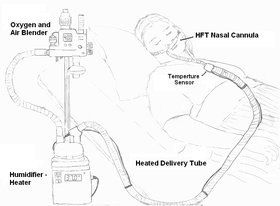Nasal Cannula O2 Rate - High Flow Nasal Cannula Oxygen Therapy In Adults Physiological Benefits Indication Clinical Benefits And Adverse Effects Respiratory Care - Nasal cannula, we assume that the fraction of oxygen that is inspired (above the normal atmospheric level or 20%) increases by 4% for every additional liter of oxygen flow administered.. Rates above 5 l/min can result in discomfort to the patient. Oxygen treatment is usually not necessary unless the spo2 is less than 92%. The maximum flow rate is at 6l/min. • conventional oxygen devices provide much lesser flows than inspiratory flow rates. 3.6 out of 5 stars. The maximum flow rate is at 6l/min. Flow rates of up to 6 litres can be given but this will often cause nasal dryness and can be uncomfortable for patients (british thoracic society, 2008). Products nasal cannula o2/co2 nasal cannula. Nasal cannulas are used to deliver oxygen whenever there is a requirement of a low flow, low or medium,which then helps the patient be in a stable state. Randomized 303 infants of less than 32 weeks to either ncpap (7 cm h2o) or hhfnc (5 to 6. The cannulae devices can only provide oxygen at low flow rates upto 5 litres per minute (l/min), delivering an oxygen concentration. Oximizer (reservoir nasal cannula) delivers 100% when breathed in. All settings are controlled independently allowing for greater confidence in the delivery of supplemental oxygen as well as better outcomes when used. That is, do not give oxygen if the spo2 is ≥ 92%. • conventional oxygen devices provide much lesser flows than inspiratory flow rates. Nasal cannula oxygen percentage chart | oxygen flow rate. Nasal cannula, we assume that the fraction of oxygen that is inspired (above the normal atmospheric level or 20%) increases by 4% for every additional liter of oxygen flow administered. If the inspiratory flow rate of the patient is greater than what is being provided by the cannula, the patient will entrain room air into the lungs. Most nasal cannulas carry oxygen flow rates up to 6 liters per minute, but there are high flow rates cannulas available. These patients were evaluated for changes in fraction of inspired oxygen (fio 2), ph, and pco 2 values after 24 hours. Nasal cannula, we assume that the fraction of. Stores oxygen in the reservoir while pt breaths out. Single nasal cannula for supplemental oxygen therapy. Even during quiet breathing, inspiratory flow rates are approximately 30 liters per minute, which exceeds supplemental oxygen flow (3). By adding nasal cannula at high flow (15 lpm) the patient immediately felt and looked better, and the pulse ox came up to 92%. Oxygen flow rate and fio2 table One patient could not tolerate the cannula. There's a new oxygen delivery device available for people with copd who are on supplemental oxygen. 3.6 out of 5 stars. Most nasal cannulas carry oxygen flow rates up to 6 liters per minute, but there are high flow rates cannulas available. • a flow rate of 15 to 60 l/minute. 20 733 просмотра 20 тыс. But patients with respiratory distress can have much higher peak inspiratory flow rates. By adding nasal cannula at high flow (15 lpm) the patient immediately felt and looked better, and the pulse ox came up to 92%. For children receiving oxygen therapy spo 2 targets will vary according to the age of the child, clinical condition and trajectory of illness. Salter cannulas deliver patient comfort and convenience. Flow rates of up to 6 litres can be given but this will often cause nasal dryness and can be uncomfortable for patients (british thoracic society, 2008). Cannulae with smaller prongs intended for infant or neonatal use can carry less than one litre per minute. The same patient may recv an md order for prn o2 ie: Nasal cannulas are used to deliver oxygen whenever there is a requirement of a low flow, low or medium,which then helps the patient be in a stable state. High flow oxygen therapy (hfot) delivers humidified o2 concentrations between 24% and 60% at flow rates up to 60 l/min to patients with mild to moderate. 20 733 просмотра 20 тыс. Stores oxygen in the reservoir while pt breaths out. Rates above 5 l/min can result in discomfort to the patient. Even during quiet breathing, inspiratory flow rates are approximately 30 liters per minute, which exceeds supplemental oxygen flow (3). If the inspiratory flow rate of the patient is greater than what is being provided by the cannula, the patient will entrain room air into the lungs. Oxygen treatment is usually not necessary unless the spo2 is less than 92%. Cannulae with smaller prongs intended for infant or neonatal use can carry less than one litre per minute. If the inspiratory flow rate of the patient is greater than what is being provided by the cannula, the patient will entrain room air into the lungs. Oxygen flow rate and fio2 table Nasal cannula, we assume that the fraction of oxygen that is inspired (above the normal atmospheric level or 20%) increases by 4% for every additional liter of oxygen flow administered. 20 733 просмотра 20 тыс. Fio2 measured = (o2 flow (ml/min) x 0.79) + (0.21 x ve) / ve x 100 where minute ventilation (ve) equals the minute An air/oxygen blender, allowing from 0.21 to 1.0 f i o 2, generates up to 60 l/min flow. There's a new oxygen delivery device available for people with copd who are on supplemental oxygen. Randomized 303 infants of less than 32 weeks to either ncpap (7 cm h2o) or hhfnc (5 to 6. Flow rates of up to 6 litres can be given but this will often cause nasal dryness and can be uncomfortable for patients (british thoracic society, 2008). A nasal cannula is generally used wherever small amounts of supplemental oxygen are required, without rigid control of respiration, such as in oxygen therapy. Products nasal cannula o2/co2 nasal cannula.
Nasal cannula the use of nasal cannula on a regular and routine basis is expected for patients on the cru.

Oxygen treatment is usually not necessary unless the spo2 is less than 92%.

For children receiving oxygen therapy spo 2 targets will vary according to the age of the child, clinical condition and trajectory of illness.
Diberdayakan oleh Blogger.
Menu Navigasi
Blogger templates
Kode Iklan Tengah Artikel
Blogroll

About
mesothelioma survival rates,structured settlement annuity companies,mesothelioma attorneys california,structured settlements annuities,structured settlement buyer,mesothelioma suit,mesothelioma claim,small business administration sba,structured settlement purchasers,wisconsin mesothelioma attorney,houston tx auto insurance,mesotheliama,mesothelioma lawyer virginia,seattle mesothelioma lawyer,selling my structured settlement,mesothelioma attorney illinois,selling annuity,mesothelioma trial attorney,injury lawyer houston tx,baltimore mesothelioma attorneys,mesothelioma care,mesothelioma lawyer texas,structered settlement,houston motorcycle accident lawyer,p0135 honda civic 2004,structured settlement investments,mesothelioma lawyer dallas,caraccidentlawyer,structured settlemen,houston mesothelioma attorney,structured settlement sell,new york mesothelioma law firm,cash out structured settlement,mesothelioma lawyer chicago,lawsuit mesothelioma,truck accident attorney los angeles,asbestos exposure lawyers,mesothelioma cases,emergency response plan ppt,support.peachtree.com,structured settlement quote,semi truck accident lawyers,auto accident attorney Torrance,mesothelioma lawyer asbestos cancer lawsuit,mesothelioma lawyers san diego,asbestos mesothelioma lawsuit,buying structured settlements,mesothelioma attorney assistance,tennessee mesothelioma lawyer,earthlink business internet,meso lawyer,tucson car accident attorney,accident attorney orange county,mesothelioma litigation,mesothelioma settlements amounts,mesothelioma law firms,new mexico mesothelioma lawyer,accident attorneys orange county,mesothelioma lawsuit,personal injury accident lawyer,purchase structured settlements,firm law mesothelioma,car accident lawyers los angeles,mesothelioma attorneys,structured settlement company,auto accident lawyer san francisco,mesotheolima,los angeles motorcycle accident lawyer,mesothelioma attorney florida,broward county dui lawyer,state of california car insurance,selling a structured settlement,best accident attorneys,accident attorney san bernardino,mesothelioma ct,hughes net business,california motorcycle accident lawyer,mesothelioma help,washington mesothelioma attorney,best mesothelioma lawyers,diagnosed with mesothelioma,motorcycle accident attorney chicago,structured settlement need cash now,mesothelioma settlement amounts,motorcycle accident attorney sacramento,alcohol rehab center in florida,fast cash for house,car accident lawyer michigan,maritime lawyer houston,mesothelioma personal injury lawyers,personal injury attorney ocala fl,business voice mail service,california mesothelioma attorney,offshore accident lawyer,buy structured settlements,philadelphia mesothelioma lawyer,selling structured settlement,workplace accident attorney,illinois mesothelioma lawyer